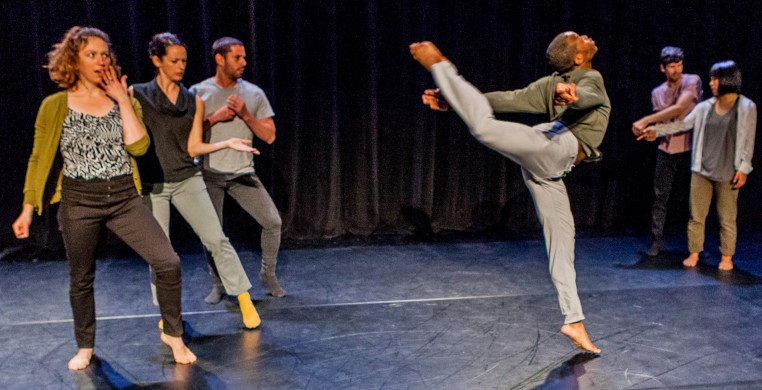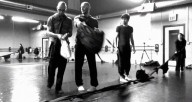Steppenwolf Theatre’s chic new 1700 Theatre is the perfect venue for Lucky Plush Productions’ “Rooming House,” an inquiry into why people make life-altering choices. Presented as part of Steppenwolf’s LookOut performance series, “Rooming House” is created and co-directed by Lucky Plush artistic director/choreographer Julia Rhoads and dramatist Leslie Buxbaum Danzig (varied times, through November 18th, 1700 N. Halsted, enter through Front Bar).
The black box style theatre offers ample space for dance and an up-close-and-personal vantage point for the audience, so personal, we feel as if we are voyeurs at the playful get-together of a group of friends.
The hour and a quarter dance/theatre hybrid tosses six Lucky Plushers tumbling from one “room” to the next where they unpack hypothetical scenarios detailing the who, where, and why of several stories in succession in a delightful blend of movement and dialog. Dance and spoken word are so well integrated, the spontaneity of the ensemble lends an improvisational feel to their carefully choreographed and often humorous interactions.
“Rooming House” borrows a party game approach from the popular board game, “Clue” for group problem-solving. Before we even know it’s a game, however, the house lights dim and a familiar voice-over intones the routine “silence your cell phones” monologue. Half-way through the litany, the faint sound of electronic interference pricks alert ears to what seems like a production mishap, but soon grows into distinct voices, and, voilà, we find ourselves eavesdropping on a story in progress. By the time the players emerge on stage mid-story, we are engrossed in the details of a house break-in and primed to follow this appealing ensemble of three men and three women wherever their storytelling takes us.
Using the “who done it” motif of “Clue” as a paradigm for behavioral speculation is a clever conceit that serves “Rooming House” well. In typical Lucky Plush fashion, shifting from one “room” to another, delineated by Alexander Ridgers’ excellent lighting, drives the action across space in a collection of movement patterns that morph in and out of pedestrian gestures, easy-going walking, running, skipping and hopping, to the more choreographic moves of barrel turns, leggy extensions, body swings, and gymnastic partnering.
The naturalism of Lucky Plush’s style capitalizes on an “anything-goes” group discovery process that meanders across a host of issues with cavalier nonchalance where trivial chit-chat hob-nobs with profundity. “Rooming House” is at its best when the story is as high-stakes as the Orpheus myth, replete with archetypal characters, daunting obstacles, and a cataclysmic decision. Asking a compelling question—why does Orpheus look back?—drives the production’s richest creativity and audience engagement, with inventive role playing, scene reconstructions, and lyrical ensemble acrobatics.
The tale of the “everyday hero” who jumps onto the subway tracks to save a man having a seizure is also about a physical action with life-altering repercussions. The other two stories, Rodolfo’s decision to leave his native Cuba, and Michel’s disillusionment with his friend over gymnastic competition are about concepts—freedom and loyalty—and make for a less effective translation to the game motif.
“Rooming House” abandons each of these stories too soon, especially the first two, before it has fully plumbed the richness of its material. The convention loses its way with stories that revolve around concepts rather than physical actions and digresses here and there with a bit too much thinking out loud where action speaks volumes.
Michael Caskey’s original music provides a nicely textured backdrop to recurring themes as the elaborate board game accelerates, revisiting snippets of the who, why, and where of each of the stories. The game ends with a seemingly arbitrary winner, and an equally arbitrary conclusion. Might as well have a beer, which everyone does, jamming together in a celebratory dance that fades into the night, no looking back. But what about Orpheus?


